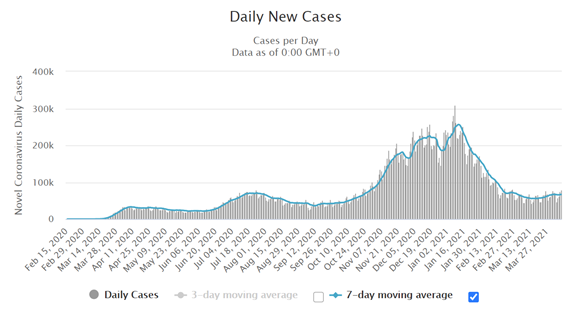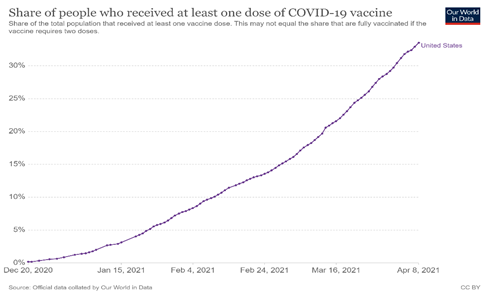Medical Risks Stabilize as Economy Continues to Improve
Presented by Tim Weller
Over the past two weeks, the medical news began to deteriorate as cases of COVID-19 and positive test rates went back up. Concerns existed as to whether the worsening numbers were a signal of another surge of the pandemic. But recent medical and economic data indicate that a significant fourth wave is not occurring. Although case growth is slightly above recent lows, it has stabilized despite the continued reopening of our economy and the spread of more contagious variants of the virus. Continued progress on the vaccination front is supporting the battle against the pandemic. Although medical risks remain, they are less significant than they were two weeks ago, and they’re dropping every week.
The news on the economy is even better. In March, the economic data indicated that we may well be seeing the beginning of a normalizing economy. As businesses reopened in many states, hiring was pushed up significantly for the third month in a row. Consumer confidence bounced to a pandemic high. Business confidence has risen even further, with recent reports marking an all-time high for the service industry and the highest level since 2006 for the manufacturing industry. The last round of federal stimulus payments should serve as an additional boost to the economy. All in all, while medical risks still exist, the economic picture looks increasingly positive.
That outlook continues to influence the markets, which have hit all-time highs despite some turbulence around rising interest rates. Let’s take a look at the details.
The Virus: Case Growth Holding Steady
New cases per day. The most obvious metric for tracking the virus is daily new cases. Case growth has remained steady over the past two weeks, although it is slightly above recent lows. The real message here is that, despite the economic reopening and more contagious variants, a mix of social distancing and increasing vaccination is controlling the virus. While another wave remains a possibility, the risks are dropping by the day. Overall, conditions remain reasonably favorable.
New daily infection rates were 80,161 on April 8, up from 77,317 a week earlier. The seven-day average for new cases per day was 66,677, holding steady from an average of 66,976 a week ago. While case growth remains too high, it appears to have stabilized at just above recent lows. This growth rate is much better than the steady rise we saw at the start of prior waves.
 Source: https://www.worldometers.info/coronavirus/country/us/
Source: https://www.worldometers.info/coronavirus/country/us/
Hospitalizations. We’re also seeing a stabilization in hospitalizations, although at a slightly higher level. On April 3, 35,536 people were hospitalized, up from 33,875 hospitalizations a week earlier. These figures represent a lagging data series resulting from case growth. Accordingly, the increasing number of hospitalizations is consistent with the data as of a couple of weeks ago. Looking at a longer time period, hospitalizations are stabilizing at close to recent lows.
 Source: https://ourworldindata.org/covid-hospitalizations
Source: https://ourworldindata.org/covid-hospitalizations
Testing news. The testing news is also showing signs of stabilization after having experienced some deterioration. Overall testing numbers have stayed at roughly the same level for the past couple of weeks, and the positive test rate remains below 5 percent. Although we would benefit from more testing, the continued low level of positive testing rates is supporting evidence that conditions remain reasonably favorable. It could also be a leading indicator that medical risks remain contained.
 Source: The Johns Hopkins University https://coronavirus.jhu.edu/testing/individual-states/usa
Source: The Johns Hopkins University https://coronavirus.jhu.edu/testing/individual-states/usa
Vaccinations. Finally, in more good news, the vaccination process continues to accelerate. More than a third of the U.S. population has had the first shot of the vaccine, compared with a quarter of the population two weeks ago. In addition, 20 percent of our population has been fully vaccinated. This progress has certainly helped keep hospitalizations low, and it has very likely helped contain the number of new infections. Vaccination continues at a high rate, and this trend is likely to continue over the next several weeks. As of now, it is very possible that everyone who wants the vaccine could be vaccinated by the summer.
 Source: https://ourworldindata.org/covid-vaccinations
Source: https://ourworldindata.org/covid-vaccinations
The major risk continues to be that a more contagious strain of the virus could take root and accelerate infections before vaccinations get sufficient traction. We are seeing some signs of this. Still, overall, the medical risks are contained and will decline as vaccinations advance.
The bottom line is that while infection growth is still too high, and risks remain, a fourth national wave is now unlikely. Although we need to keep an eye on the medical numbers, the stabilization over the past two weeks, combined with the ongoing vaccine deployment, will continue to reduce the risks. We are not out of the woods yet, but we are getting much closer to that point.
The Economy: March Data Shows Strength
The economic data continues to get better. March job growth came in much stronger than expected, with 916,000 jobs added. Unsurprisingly, given that employment news, consumer confidence bounced to a pandemic high. As we can see in the chart below, consumer spending bounced from 1.6 percent below pre-pandemic levels to 5.5 percent above pre-pandemic levels—a significant improvement. Also in March, business confidence moved to a decade-plus high. Better spring weather and the federal stimulus package should continue to be a tailwind, so we are likely through the worst of the economic impact of the pandemic.
 Source: https://tracktherecovery.org/
Source: https://tracktherecovery.org/
As the economic effects of COVID-19 recede into the past, the economy looks like it will continue to grow even if we see a short-term reversal of the improvements in medical risks. Although the medical uncertainties are real, most of the economic risks are diminishing.
The Markets: New Highs Recorded
Markets saw some volatility in past weeks, which was largely attributable to increases in interest rates. But this situation also represents progress, as the increased volatility is based on continued economic improvement. Despite the turbulence, the markets continue to expect a much better 2021 due to the ongoing medical and economic improvements. That outlook has continued to support prices. Fourth-quarter earnings came in well ahead of expectations. As a consequence, analysts are adjusting their 2021 earnings estimates upward, which suggests that positive market trends may continue. Markets remain at or close to all-time highs, and as the economy continues to grow we may see more gains.
Good Prospects for Normalization
Overall, economic conditions are currently favorable. Although medical risks are still real, they are declining. In addition, the reopening of state economies and the federal stimulus package have supported the most vulnerable parts of our economy. Significant improvements have been made in getting people back to work. Confidence on the part of consumers and businesses is robust and looks likely to remain so, even if medical risks increase in the short term.
As for the stock markets, future gains will depend on further improvement in the medical and economic news. Of course, market gains are not guaranteed, especially in the short term. More market swings should be expected.
Regarding longer-term economic expectations, the good news is that vaccines are now rolling out quickly. By the time summer arrives, we should be approaching the end of the pandemic. The economy will be able to normalize and start to really grow again. Despite the real risks that remain, including the possibility of a medical setback, we continue to make progress.
Certain sections of this commentary contain forward-looking statements that are based on our reasonable expectations, estimates, projections, and assumptions. Forward-looking statements are not guarantees of future performance and involve certain risks and uncertainties, which are difficult to predict. Past performance is not indicative of future results.
Weller Group is located at 6206 Slocum Road, Ontario, NY 14519 and can be reached at 315-524-8000. Securities and Advisory Services offered through Commonwealth Financial Network®, Member FINRA/SIPC, a Registered Investment Adviser. Fixed insurance products and services serviced through Weller Group LLC and KAFL, Inc. are separate and unrelated to Commonwealth.
Authored by Brad McMillan, CFA®, CAIA, MAI, managing principal, chief investment officer, at Commonwealth Financial Network®.
© 2021 Commonwealth Financial Network®
